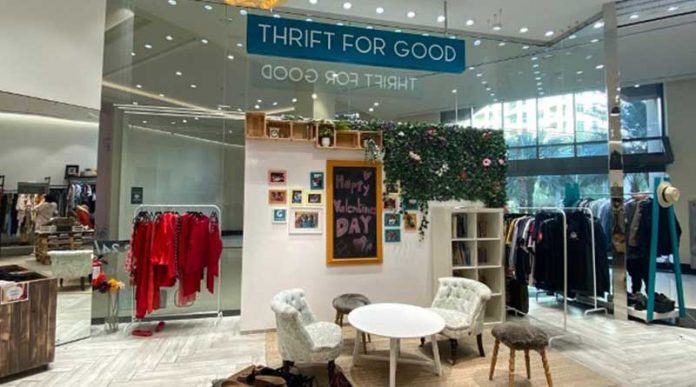In a modern world where fast fashion is embraced and encouraged, Thrift for Good pushes the fashion industry to new limits with its initiatives.
By Hala Nasar
Racks of clothing paint the walls of a retail store, the colors creating a harmony in every corner and crevice of the clothing wonderland. However, it is not just any retail store; it is a thrift store. Thrift for Good collects pre-loved items from people in the United Arab Emirates and from around the world. The items undergo rigorous cleaning, repairing, and a polishing process so they can be sold at cheap prices to help children in need of food, education, or shelter.
Thrift for Good’s success story
Started in April 2020 as an online thrift store, Thrift for Good became more popular once they opened their first store in November 2020. A year and a few months later, Thrift for Good has already raised one million dirhams for charities around the globe. They still manage to collect donations online, but their store is in an easy access location for many, being in the heart of Dubai.
Their initiative focuses around reselling items they receive to raise funds for children’s charities around the world. Their aim is to promote the second-hand market and stick to a zero-waste policy.
“We are not just a bargain shop, we are a charity, and we are doing something good for others,” said Sama Mahagamage, employee at Thrift for Good.
Their first step was opening the store in Dubai, and they partnered with multiple organizations to make this happen. They have several partners, their main partner being Gulf for Good, a charity organization supporting children around the world.
“I think we need to have more like this [thrift stores], it is [an] excellent initiative of repair, reuse, and recycle; more people need to do that,” said Vanya A., a regular customer and item donor for Thrift for Good.
The process of reselling donated items
At Thrift for Good, donated items go through a strict routine to ensure hygiene, and safety protocols are maintained during transactions.
One of their sponsors, Amazeus Laundry, washes the items received as donations.
Once the washing is over, several of the partnered organizations work on upcycling the donated items. If any stains or damage is found on those items, these organizations work on restoring the item as best as they can.
Steaming and pricing the items come next. A team of Thrift for Good employees and volunteers work to make the garments look as presentable as possible for customers to buy.
The items are arranged based on color or type on racks within the store for easier selection.
“They have a compliance team in charge of cleaning, decorating, and taking care [of donations],” says Jo Roper, a regular at Thrift for Good.
While there are people of all ages working in the store, Aaryan Gregory, a 13-year-old volunteer, works on putting the price tags on the items. He says that their garments range from low-end all the way to high-end.
How is it sustainable?
“The fashion industry is one of the biggest polluters,” says Vanya, endorsing the second-hand market, “people in Dubai buy a lot, and use less.”
One of the main problems existing in the fashion world is the promotion of fast-fashion and the control that it has on shopping addicts.
Customers at Thrift for Good argue that sustainability lies in repurposing second-hand items, including clothing, accessories, shoes, handbags and books.
“If it is washed, what’s there not to be okay?” says Vanya.
The element of sustainability is highlighted in the packaging Thrift for Good uses and the second-hand nature of their purchases.
“It is necessary to come here every day,” says Roper.
So, if you find yourself in the mood to help children and save the planet, buy some clothes. Make sure they are thrifted, though.


















